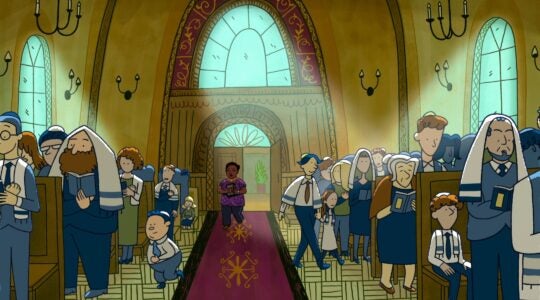I admit it. I dropped the ball on the story about the new remember-the-Holocaust-by-printing-the-word-Jew-six-million-times book. I saw it sitting in a veteran Jewish journalist’s office a week ago, but forgot to bring it up to my fellow JTA editors.
And then I look at the front page of the Times on Sunday and there it is.
The truth is, when I first looked through it, I couldn’t get past wondering about the copy editor. Did he/she have the easiest or hardest job in the world?
But thinking about it more later, the project rubbed me the wrong way. And my uneasiness only increased after reading how the author — maybe creator is the better word — explained the project to the Times’ Jerusalem bureau chief, Jodi Rudoren.
“When you look at this at a distance, you can’t tell whether it’s upside down or right side up, you can’t tell what’s here; it looks like a pattern,” said Phil Chernofsky, the author, though that term may be something of a stretch. “That’s how the Nazis viewed their victims: These are not individuals, these are not people, these are just a mass we have to exterminate.
“Now get closer, put on your reading glasses, and pick a ‘Jew,’ ” Mr. Chernofsky continued. “That Jew could be you. Next to him is your brother. Oh, look, your uncles and aunts and cousins and your whole extended family. A row, a line, those are your classmates. Now you get lost in a kind of meditative state where you look at one word, ‘Jew,’ you look at one Jew, you focus on it and then your mind starts to go because who is he, where did he live, what did he want to do when he grew up?”
I have no major quibble with seeing this book as a testament to how Nazis looked at the Jews. But for the same reason that it might work on that level, it strikes me as a terrible form of memorialization, especially since most of Hitler’s Jewish victims are not nameless.
Rudoren’s story went right to my next thought — Yad Vashem and its database of victims:
While many Jewish leaders in the United States have embraced the book, some Holocaust educators consider it a gimmick. It takes the opposite tack of a multimillion-dollar effort over many years by Yad Vashem, the Holocaust memorial and museum here, that has so far documented the identities of 4.3 million Jewish victims. These fill the monumental “Book of Names,” 6 1/2 feet tall and 46 feet in circumference, which was unveiled last summer at Auschwitz-Birkenau.
“We have no doubt that this is the right way to deal with the issue,” said Avner Shalev, Yad Vashem’s director. “We understand that human life, human beings, individuals are at the center of our research and education. This is the reason we are investing so much in trying to retrieve every single human being, his name, and details about his life.”
Clearly this project works for some folks. According to the Times, the Anti-Defamation League’s Abe Foxman lined up a few donors to buy 3,000 copies to send around.
“When he brought me this book I said, ‘Wow, wow, it makes it so real,’” Foxman reportedly said. “It’s haunting.” (OK, I’m a little hurt about not being on Abe’s comp list, but I promise that has nothing to do with this post.)
But still, I just don’t see it. The Nazis may have indeed murdered our people en masse, but that’s no reason for us to play along. We have 4.3 million actual names. I’d rather see them put in a book and have people ruminate on that.
JTA has documented Jewish history in real-time for over a century. Keep our journalism strong by joining us in supporting independent, award-winning reporting.





